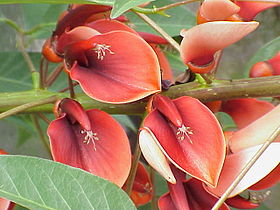| This article needs additional citations for verification. Please help improve this article by adding citations to reliable sources. Unsourced material may be challenged and removed. Find sources: "Flora of Uruguay" – news · newspapers · books · scholar · JSTOR (June 2013) (Learn how and when to remove this message) |

The flora of Uruguay consists of 2,500 species distributed among 150 native and foreign biological families. Approximately 80% of Uruguay is prairie, with grasses predominating. Uruguay is primarily a grass-growing land, with vegetation that is essentially a continuation of the Argentine Pampas. Forest areas are relatively small. Trees grow in bunches.
Forested areas are much smaller than in the pampas, but contain a mix of hardwoods and softwoods, while eucalyptus were imported from Australia.

"Ceibo", or Erythrina cristagalli, is the national flower.
Herbs
Uruguay contains many herbs, ferns, and flowers.
Riverine forests
Natural forests in Uruguay mainly grow near rivers in the countryside.
The native forests are composed of more than 500 native species, including palms. The most abundant are "sauce criollo" (Salix humboldtiana), "sarandí colorado" (Cephalanthus glabratus), "sarandí blanco" (Phyllanthus sellowianus) and "mataojos" (Pouteria salicifolia).
Natural prairie
The natural prairie in Uruguay constitutes about 14,000,000 acres (5,700,000 ha) (80% of the country) and contains some 2000 species including 400 grass species. The prairie includes Canelones, Colonia, San Jose, Flores, Florida, Lavalleja and Soriano.
In the prairies "Tala" (Celtis tala), "Molle rastrero" (Schinus longifolius), "Espina amarilla" (Berberis laurina) and "Coronilla" (Scutia buxifolia) thrive, and Cortaderia selloana can be found.
Native bushes
In the valleys, bush lands dominated by shrubs instead of trees or grasses predominate. Common native bushes include (Scutia buxifolia), "Arrayán" (Blepharocalyx salicifolius), "Chal-Chal" (Allophyllus edulis), and "Guayabo Colorado" (Eugenia cisplatensis).
Gallery
-
 Pampas grass
Pampas grass
-
Prairie and forest in San José
-
River forest near Río Queguay
-
National park, espinillos, Río Queguay
-
National Park, Prosopis spp.
-
A creek forest, near Valle Edén
See also
References
- Piaggio, Mario. "Vegetación del Uruguay". Micología. Facultad de Ciencias. Retrieved 31 May 2013.
- Grupo Guayubirá (1995-01-01). "Listado de especies de flora nativa del Uruguay".
External links
- national flower of Uruguay: Ceibo Erythrina
- Vegetacion del Uruguay
- Grupo Guayubira en Defensa del Monte Indigena
- ElUruguayo.com Flora Geografía del Uruguay Enciclopedia
- La Flora de Uruguay Easyviajar.com Archived 2016-04-25 at the Wayback Machine
You can help expand this article with text translated from the corresponding article in Spanish. (November 2021) Click for important translation instructions.
|
| Flora of South America | |
|---|---|
| Sovereign states | |
| Dependencies and other territories | |
